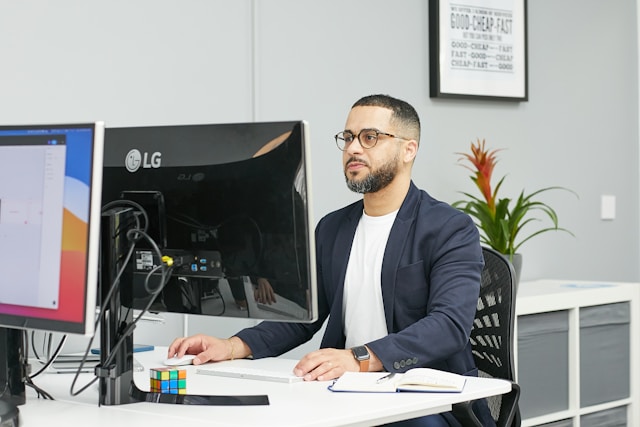Business
Best Business Plan Competitions For Entrepreneurs

As an entrepreneur, sometimes it may seem like your idea is everything. After all, without your ingenious idea, there is no company to build. Yet, there are many steps to take in order to develop that idea. Having a strong business plan is a must.
Through the research and writing it requires, the plan takes what was initially nothing but an innovative idea and makes it into a possibility. It helps you lay out every conceivable aspect of your business, including the executive summary, a company and team description, the copyrights involved, your market research, and the business’ financial plan.
Each section allows the reader to get to know your business, its profitability, expenses, and market impact. They also help you and your team to keep track of the company’s growth through the weeks, months, and years.
In any startup business plan that you may download from the best business templates site, the most important function is its ability to attract funding, and not simply through loans, investors, or credit unions. A strong business plan can bring your company independent capital through business plan competitions, a well-capitalized but underutilized resource for entrepreneurs.
The competitions usually consist of elaborating on your business idea in a concise business plan, a pitch deck presentation, and (often) a display of the company’s product or service. The presentation is done in front of an acclaimed panel of judges formed by local industry leaders, other investors, or entrepreneurs.
The panel judges your presentation based on the competition’s specific criteria and performance metrics. On some occasions, like during the 2005 Rice University Business-Plan Competition, the venture capitalists present can offer the participants even more than the original prize.
You can find business plan competitions focused on a variety of markets. Some are focused on a single industry, some are specifically for college startups, and others are open to anyone with a great marketing and financial plan. Here is a list of five competitions you could apply to.
tecBRIDGE Business Plan Competition
For over two decades the Northeastern Pennsylvania based organization now known as tecBRIDGE has made an effort to promote technology-based economic development, entrepreneurship, and innovation in its region.
Since 2002, the tecBRIDGE Business Plan Competition has been a platform for their mission. The competition is divided into collegiate and non-collegiate divisions. Non-collegiate participants must have gross revenue of $250k or lower since the founding of the business. They must also submit a plan which identifies commercial solutions for technical products or services. Team registration deadlines for the annual competition are due in February.
Milken-Penn GSE Education Business Plan Competition
For 10 years, Penn GSE and the Milken Family Foundation have joined forces to help kickstart educational businesses. The Milken-Penn GSE Education Business Plan Competition allows educational entrepreneurship ventures from around the world to present their plans in front of a panel of industry experts.
The ventures can address any educational issue, from workforce learning to early childhood education to special education, but they may not have raised nor earned more than $500k in gross revenue since their legal foundation.
Besides the usual sections of a business plan, the competition’s application includes the submission of a digital slide deck presentation with a maximum of 15 slides and a 60-second video pitch. The annual competition is a great platform for potential funding and for great networking.
Citizen Entrepreneurship Competition
In 2001, German professor Günter Faltin started the Entrepreneurship Foundation with the goal of helping people of all ages around the world to create sustainable businesses. The foundation’s Citizen Entrepreneurship Competition is meant to encourage business owners and innovators around the world to do just that.
Their venture, project, or idea must have some sort of societal impact which affects one or more of the United Nations’ 17 Sustainable Development Goals (SDGs). The SDGs include poverty, world hunger, health and well-being, quality education, responsible consumption and production, and development of industry, innovation, and infrastructure.
The competition is divided into a Youth section for those between the ages of 13 and 29. The Adult Citizen Entrepreneurship category serves applicants who are 30 years old and older.
Get in the Ring
Frustrated by the number of startups they saw fail every year because of funding and resource needs, the technology scouting company Unknown Group created Get in the Ring. The group’s goal is to give these ventures the tools they need to thrive, and they do so through three platforms—a competition, a challenge, and a global meetup.
The annual competition, which began in 2012, invites entrepreneurs with ventures that contribute to the solving of today’s grand challenges. It is divided into five competitions that meet different needs—clean energy, food and agriculture, health, workforce augmentation, and impact (which focuses on the SDGs).
The winners of the competition are welcomed to the global meetup, a three-day retreat where startups from 150 countries present their innovations to hundreds of investors, industry experts, and other business owners.
Rice Business Plan Competition
For 20 years, Rice University’s competition has given collegiate entrepreneurs a chance to get real-world experience and opportunities in business launching. Only two of the team members need to be Rice students and another member must be a graduate-level student. The competition is aimed at businesses in the sectors of energy and sustainability, science, technology, and other innovation.
The application consists of a 20-question survey and the submission of a two to five-page executive summary. Participants are encouraged to add a 60 to 120-second video pitch. Only 42 of the hundreds of annual applicants get a chance to participate in the competition, where a group of 200 judges made up of industry leaders, venture capitalists and national investors choose worthy winners.
Last year, more than seven teams won awards of $100,000 or more.
Choose the right competition for your business, prepare your plan, and pitch for when the deadlines open and get ready to compete.
Business
MetaWorx: Building Full-Stack AI Teams, Not Just Automation

Automation still dominates most headlines, yet the returns often fail to meet expectations. A sprawling chatbot rollout might shave a few support tickets, but it rarely shifts the profit-and-loss statement in a lasting way.
McKinsey’s 2025 workplace survey pegs AI’s long-term productivity upside at $4.4 trillion, but only one percent of enterprises say they’ve reached true “AI maturity.” MetaWorx, a New York-based consultancy founded by Rachel Kite, argues that the shortfall has nothing to do with models and everything to do with people.
“Treat AI like a point solution and you’ll get point-solution results,” shares Kite. “You need a roster that can carry the ball from raw data to governance, or the whole thing stalls at the proof-of-concept phase.”
The pod blueprint
When a plug-and-play automation script collapsed under real-world data drift, costing Kite a lucrative contract, she sketched the six-person “pod” that now anchors every MetaWorx engagement:
- An infrastructure architect to tame compute costs.
- A data engineer to secure and shape pipelines.
- An applied scientist to prototype models against live feedback loops.
- An MLOps engineer to automate rollback and retraining.
- A domain product lead translates forecasts into features users actually notice.
- Ethics and compliance analysts to stress test outputs for bias and keep the audit.
The team’s first sprint still delivers a quick-win bot — “small enough to calm the CFO,” jokes Kite — but the roadmap quickly pivots to reliability, explainability, and eventually optimization. By tying every algorithmic decision to a quantifiable business metric, the pods turn AI from a science project into a growth lever.
Recruiting for curiosity, not credentials
With Bain & Company predicting a global AI-skills crunch through 2027, MetaWorx has stopped chasing unicorn résumés. Instead, it hires “adjacent athletes”: a computer-vision PhD who hops from medical imaging to warehouse surveillance, or a former journalist who recasts her nose for story into prompt-engineering finesse.
“Domain expertise expires fast,” Kite says. “What doesn’t expire is the instinct to ask better questions.” The result is a lattice of overlapping skills that stays flexible when models wander into the long tail of edge-case data.
A culture of rapid experiments
Inside MetaWorx, every idea faces the same litmus test: ship something — anything — into a user’s hands within 21 days. The “three-week rule” forces prototypes into the wild early, where failure is cheap and feedback is swift. Post-mortems, including cost overruns, are circulated company-wide, erasing any stigma associated with missteps.
That laboratory mindset powers velocity. “Our first model is almost always wrong,” Kite admits, “but version 1.0 is the tuition we pay for version 2.0.” The philosophy echoes her TEDx talk on resilience: progress is iterative, not heroic.
How leaders can steal the playbook
Executives itching to replicate MetaWorx’s results don’t need a blank check. Kite offers a five-step sequence:
- Inventory pain points, not tools: Walk the P&L line by line and tag the friction you can measure.
- Map the stack to the problem: A recommendation engine, for instance, requires behavior data, retraining triggers, and feedback capture — automation alone won’t suffice.
- Stand up a pod: Reassign existing talent into a cross-functional tiger team before hiring externally; the chemistry test is free.
- Measure the story, not just the statistic: Pair model accuracy with human-scale metrics like ticket backlog or employee churn.
- Budget for the boring: Reserve at least 30 percent of spend for MLOps and governance; Stanford’s HAI review links most AI failures to neglected upkeep.
Taken together, those steps shift AI from a pilot novelty to an operational habit that compounds value rather than topping out after an initial PR splash.
Character still scales faster than code
MetaWorx plans to double its headcount this year, yet Kite insists the secret isn’t a proprietary framework or a monster war chest. It’s credibility. Clients see a founder who has wrestled with the same outages and surprise bills they face. That authenticity converts skeptics faster than any algorithmic novelty.
“Tools level out,” Kite says. “Culture compounds.”
The insight lands in a marketplace still dazzled by generative fireworks. Yes, MetaWorx ships models and dashboards, but its true product is a mindset: resilience over rigidity, questions over credentials, experiments over edicts. In Kite’s world, automation is merely the appetizer. The main course is a full-stack team that knows why the model matters to the business and who owns its success after launch day.
And that, Kite argues, is how AI finally graduates from cost-cutter to growth engine, one curious pod at a time.
-

 Tech4 years ago
Tech4 years agoEffuel Reviews (2021) – Effuel ECO OBD2 Saves Fuel, and Reduce Gas Cost? Effuel Customer Reviews
-

 Tech6 years ago
Tech6 years agoBosch Power Tools India Launches ‘Cordless Matlab Bosch’ Campaign to Demonstrate the Power of Cordless
-

 Lifestyle6 years ago
Lifestyle6 years agoCatholic Cases App brings Church’s Moral Teachings to Androids and iPhones
-

 Lifestyle4 years ago
Lifestyle4 years agoEast Side Hype x Billionaire Boys Club. Hottest New Streetwear Releases in Utah.
-

 Tech6 years ago
Tech6 years agoCloud Buyers & Investors to Profit in the Future
-

 Lifestyle5 years ago
Lifestyle5 years agoThe Midas of Cosmetic Dermatology: Dr. Simon Ourian
-

 Health6 years ago
Health6 years agoCBDistillery Review: Is it a scam?
-

 Entertainment6 years ago
Entertainment6 years agoAvengers Endgame now Available on 123Movies for Download & Streaming for Free
